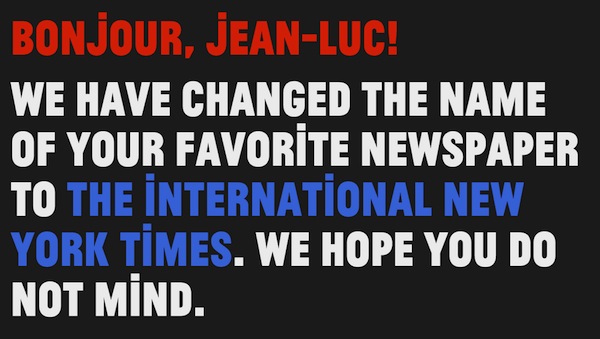
The International Herald Tribune officially became a thing of the past this morning, as the 126-year-old newspaper officially became the International New York Times.
(A style aside for people in our line of work: It should be the International New York Times, lowercase on the “the,” even though it’s still The New York Times. A carryover, one imagines, from the IHT, which was similarly downcased. That’s despite the fact that Times style is to capitalize the The in every newspaper name, even those — like the Chicago Tribune or the Houston Chronicle — that don’t capitalize it themselves. It’s strange.)
Renaming the Paris-based daily paper — founded 1887, fully under Times control since late 2002 — is part of the Times’ overall strategy to make non-U.S. revenue a bigger part of its business. Over the past few years, The New York Times Co. has jettisoned just about every part of its business that wasn’t The New York Times — selling assets like About.com, The Boston Globe, and its smaller regional dailies; this move brings its largest remaining ancillary asset under the NYT umbrella, « plus de 125 ans après son lancement à Paris. »

The branding shift is most prominent in print, but the underlying reasoning is digital. Times CEO Mark Thompson told the paper 15 million to 20 million “unique international users” go to NYTimes.com each month and that 10 percent of the paper’s digital subscribers are outside the United States. (Arthur Sulzberger has talked about improving the experience for international digital subscribers, including accepting their money in non-dollar currencies.) Here’s Sulzberger:
Only a few decades ago, The New York Times was a well respected but metropolitan newspaper. My father, Arthur Ochs Sulzberger, had the vision to make The Times a national newspaper in 1980. Though seen as a gamble at the time, it was clearly the right decision.
Today, our future is global. The need for high-quality, authoritative, on-the-ground reporting and analysis from around the world has never been greater.
To promote the switch, the Times is making access to NYTimes.com and its new international counterpart, as well as the Times iOS apps, free for five days. The free access is sponsored by Citi, which also recently sponsored part of the Times’ Scoop app for iOS.
The Times is also marking the occasion with a quick world tour and a few looks back at the history of the paper, made famous by the likes of Hemingway and Godard. (Don’t linger too long on the 1932 IHT editorial “Fascism for America.”)

To emphasize the international reach of the paper, executive editor Jill Abramson, Times media columnist David Carr, Thompson, and others are opening up their passports, making stops in Paris, Tel Aviv, Hong Kong, and Tokyo for panels, forums and other events. Joe Pompeo has the itinerary over at Capital New York:
The marketing and press push will resume Friday in Tel Aviv, where Thompson and INYT publisher Stephen Dunbar-Johnson are scheduled for a panel discussion at the Peres Center for Peace hosted in conjunction with the Isreali newspaper Ha’aretz.
Then on Monday, Oct. 21, Dunbar-Johnson and Times Company vice chairman Michael Golden will host a reception at the DealBook Global Forum in Hong Kong.
On the 23rd, in a joint event in Tokyo tied to a new partnership with The Japan Times, Andrew Ross Sorkin will join a discussion on “Innovation, Investment and the Japanese economy.” The next day there’s a Tom Friedman talk about “hyperconnectiveness” in Singapore, where his Global Forum takes place the following day.
Part of the transition to a International New York Times has meant shuffling and reorganizing the staffs of the two papers, in the Paris newsroom as well as in bureaus around the world. They’ve also expanded the opinion section of the International New York Times, with new writers for the paper’s editorial board as well as more than two dozen new contributing opinion writers (including recent Nieman Fellow Maxim Trudolyubov).
While the Times is moving forward with an eye on the future, they’re also celebrating the history of the International Herald Tribune, a paper that was very much part of a different era of newspapering — but one that, like ours, is driven both by visionary leadership and by technological change:
The International Herald Tribune was the latest incarnation of a newspaper founded in Paris 126 years ago as the European edition of the New York Herald, which was a rival of the Times in the bruising mid-19th century New York newspaper industry. James Gordon Bennett Jr., son of the founder of the sensationalist and popular Herald, put to use new trans-Atlantic cable just as readers were spreading out by rail and steamship.
Over the years, the Herald Tribune became an ink-and-newsprint staple for U.S. expatriates and foreigners looking for a dose of Americana. For more than a century, it was one of the few distributors of English-language news — plus baseball scores, daily crosswords, and comic strips — to readers in far-flung corners of the globe.
The staff of the IHT produced an interactive special section looking back on the history of the paper, its reach, and its reporting. It’s worth diving into if you’re curious about things like famous front pages from the paper’s history, the editorial after the day the USS Maine was sunk, or Art Buchwald’s thoughts on the the wedding of Grace Kelly.